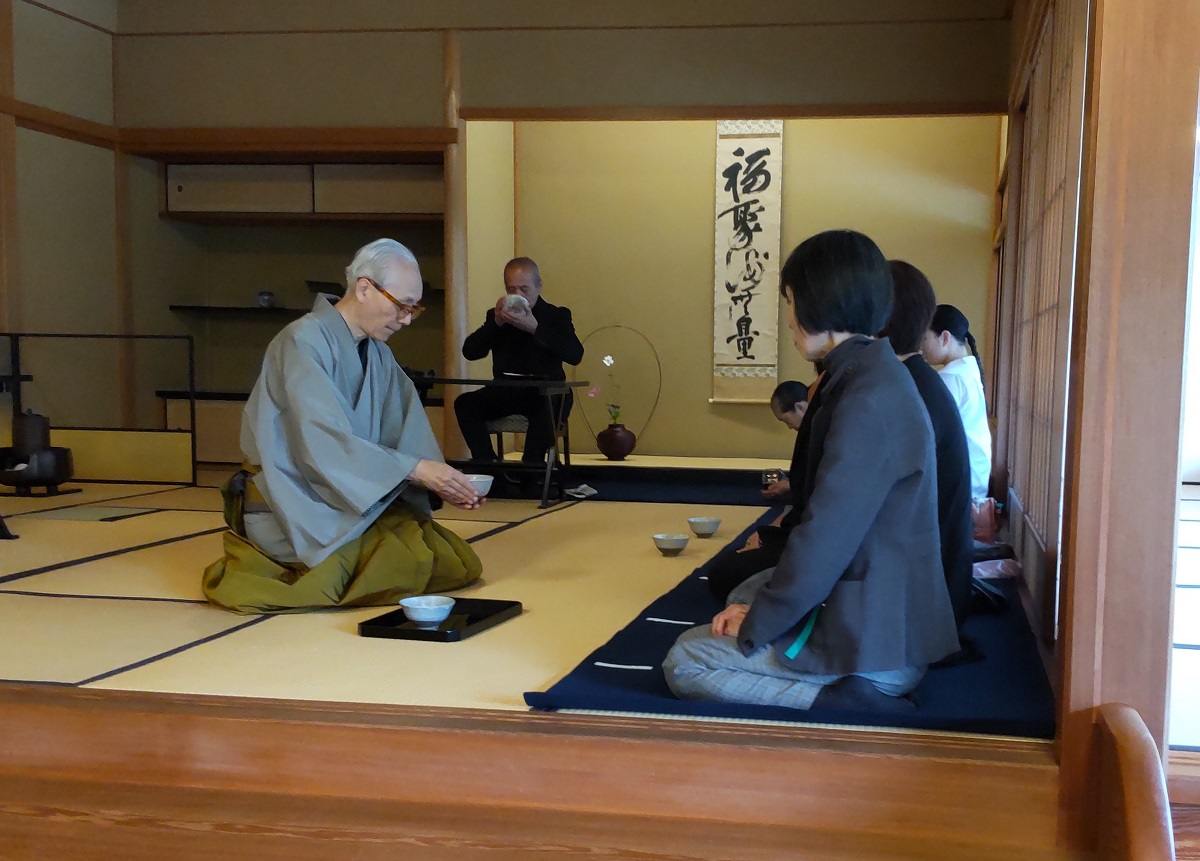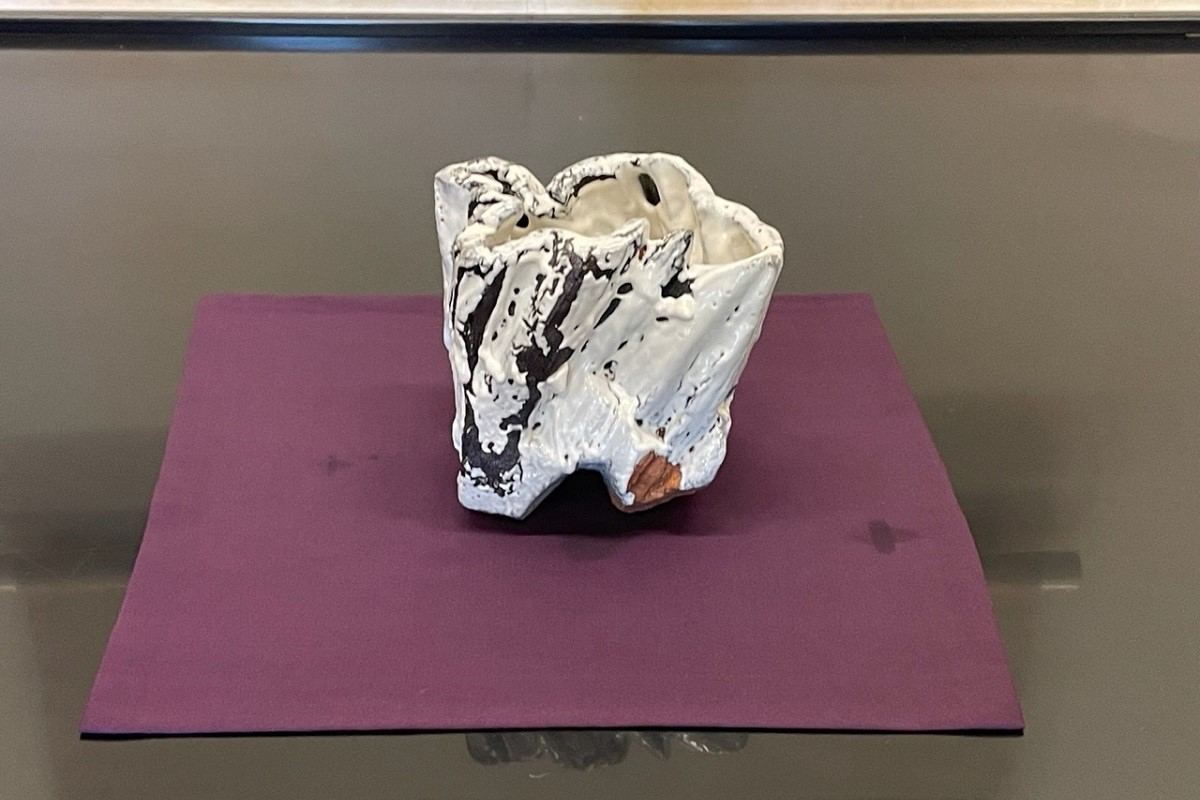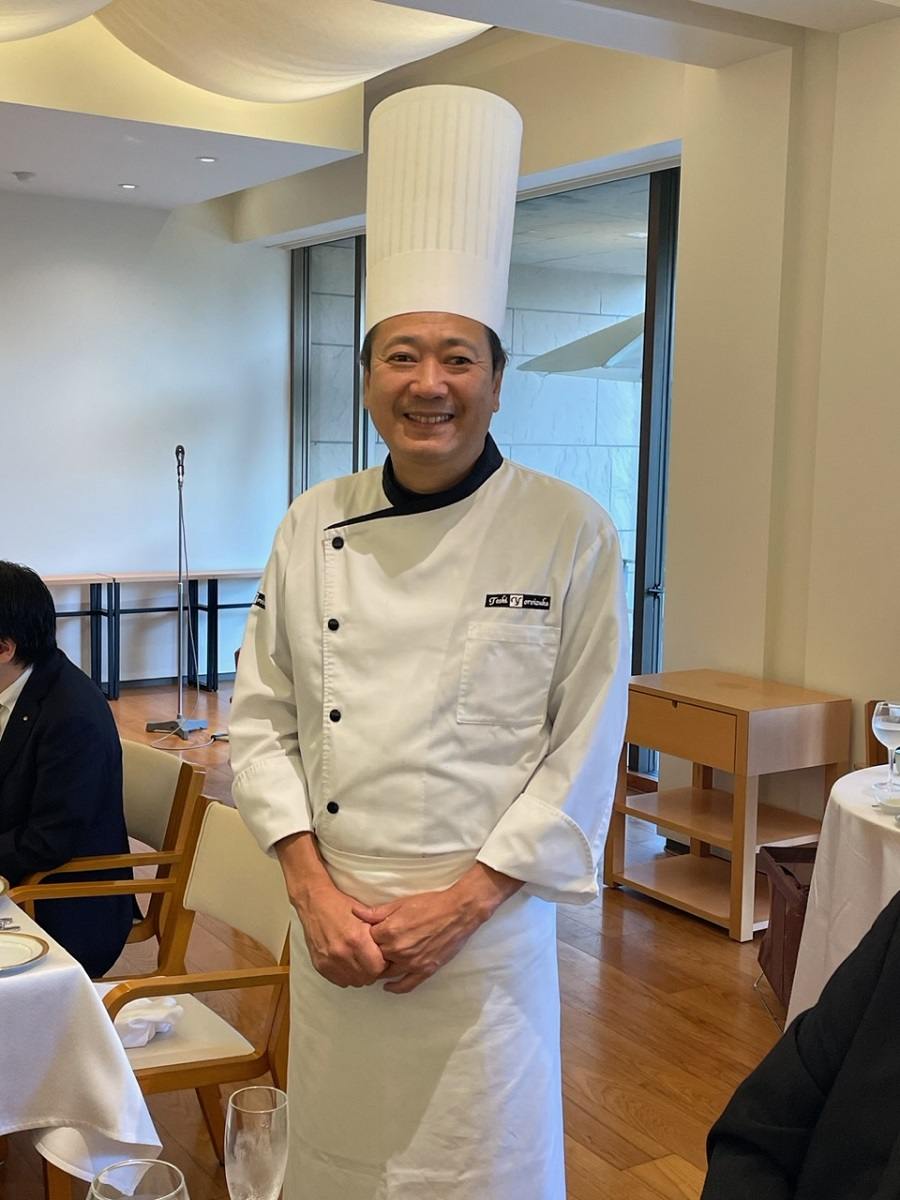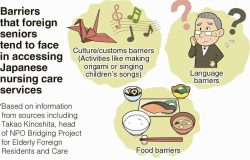
MOA Museum of Art Executive Director Tokugo Uchida, left, and ceramist Miwa Kyusetsu XIII, at rear, participate in a tea ceremony demonstration at the museum’s Ippaku-an teahouse on Nov. 7.
11:27 JST, November 30, 2023
What an abundance of riches, and what an honor to experience them.
From the moment the Kogei Dining event began at the MOA Museum of Art in Atami, Shizuoka Prefecture, I was treated to a feast of Japanese artistry and culture: a tea ceremony experience featuring remarks by a renowned ceramist, lunch prepared by a top patissier, and finally, a performance by a living national treasure of kabuki.
Each man’s creations left me deeply moved, as did his devotion to his art and the inspiration it can give to others.
Kogei Dining is part of the Japan Cultural Expo 2.0 program organized by the government to promote tourism, culture and the arts. Launched in 2019, Kogei Dining is dedicated to the principle that works of kogei — often translated as “crafts,” an English word that falls far short of their richness and depth — must actually be used, not just looked at, for their full beauty to be appreciated.
“I hope people can experience the entirety of Japanese culture,” MOA Executive Director Tokugo Uchida said during an interview.
“For example, when you drink tea in a teahouse, you have the teahouse itself, a hanging scroll inside and the bowl you drink from. There’s also the garden in front linking you to nature. You wear a kimono. All of this is Japanese culture.”
The most recent Kogei Dining event took place over Nov. 5-7 at the Atami museum. I participated in the last day, starting at the Ippaku-an teahouse on the grounds of the museum. Here Miwa Kyusetsu XIII, the 13th master of his family’s Fusoan Miwagama kiln in Hagi, Yamaguchi Prefecture, spoke about his career and his approach to his medium with Uchida.
Lively and warm, their talk ranged as far back as Miwa’s childhood and the fascination he felt during the spring tilling of the rice fields.
“They didn’t use a machine back then,” recalled Miwa. “A dark black cow would pull a plow, churning up the black earth. Even though I was small, I was fascinated by the movement, the shining, the faint smells.”
“I was conscious of the earth itself,” he said. “I think that was a primal experience for me.”
“I’ve wanted from a very young age to channel the energy of the earth into my work,” Miwa said.

Miwa Kyusetsu XIII, left, speaks during an interview with The Japan News on Nov. 7.
After their talk, and a service of matcha and a traditional Japanese sweet, we were able to examine and even hold some of Miwa’s pieces, including a large, craggy tea bowl from his “El Capitan” series inspired by the eponymous rock formation in California’s Yosemite Park.
Strength and tranquil permanence radiated from its form — looking back, the bowl seems to epitomize a philosophy held by Miwa’s father, which Miwa described during an interview later in the day.
“Near the end of his life, my father would say that his tea bowls were a tool for drinking tea, but they couldn’t just be a tool. He wanted those who saw them and used them to think, ‘Alright, I’ll do my best again from tomorrow!’ He wanted them to give people that energy for life,” Miwa recalled.
“I really understand that recently, I’ve come to feel the same way. I want to create works that will give people strength.”

A tea bowl from Miwa Kyusetsu XIII’s “El Capitan” series
Culinary delights
Miwa’s talk with the museum director was followed by a sumptuous lunch of French cuisine, made primarily from local ingredients, in the MOA’s La patisserie du musee par Toshi Yoroizuka. (Attendees on the first two days of the Atami event enjoyed Japanese kaiseki cuisine prepared by chefs of the museum’s Hana-no-Chaya restaurant.)

Patissier Toshi Yoroizuka
Seven courses were presented by acclaimed patissier Toshi Yoroizuka, who trained for eight years in Europe. Yoroizuka cheerfully explained the composition of each dish as it was served, including the richly flavored tarte tatin apple tart that he declared with a laugh to be the “real main course.”
Like all the day’s featured artisans, Yoroizuka spoke entirely in Japanese but future foreign guests need not be deterred — interpretation services will be available on request.
If this meal was any indication, Kogei Dining guests should always come with a thoroughly empty stomach. I reluctantly left half my tart on the plate, unable to manage even one more bite. I also refrained from the various wines matched to different parts of the meal — one of the drawbacks of being on the job — but the reaction of my fellow diners left no doubt they were excellent.
And here too we experienced the beauty of Japanese kogei in the tableware, including light blue sake cups that seemed almost to glow with an internal light. These were the work of Zenzo Fukushima, a living national treasure of Koishiwara ware ceramics.
Conversation and laughter flowed over a leisurely two hours, amid windows overlooking the museum garden on one side and a serene white artwork evocative of a Japanese rock garden along the opposite wall.

Tarte Tatin with cinnamon-flavored ice cream
Feminine grace
After lunch we moved to the museum’s Noh Theater to see a dance and musical performance by Bando Tamasaburo, Japan’s leading kabuki performer of onnagata female roles. He appeared in the guise of a woman throughout, graceful and refined in every movement.
The first part of his appearance involved remarks to the audience, as part of which Tamasaburo modeled a number of kimono from his long career. Each was magnificent — I especially admired a garment with a pattern of windblown autumn leaves and flowers. But the audience’s loudest gasps of appreciation surely came for the final kimono, a vibrant red creation covered in gold embroidery, including a great bird spreading its wings across Tamasaburo’s back. It seemed afire amid the theater lights.
Tamasaburo next performed “Sankyokuito no Shirabe” from the kabuki play “Dan no Ura Kabuto Gunki,” in which a prostitute is charged to reveal the whereabouts of her lover, who has disappeared following the fall of the Taira clan. She does not say and is therefore submitted to a form of “mental torture,” told that if she plays three instruments without error, she will be deemed innocent.
Clad in yet another resplendent kimono, this time with a peacock draped down the obi sash in front, Tamasaburo performed a stately dance before the audience. He then played a koto, shamisen and kokyu stringed instrument in perfect time with the accompanying performers on the side of the stage.
The applause was loud and sustained as the performance came to a close, but finally it was time to go. Kogei Dining participants ended the day with a visit to the ongoing exhibition of Miwa’s work at the museum, “Miwa Kyusetsu XIII Creating Forms in Chanoyu,” and the opportunity to purchase kogei pieces. The exhibition runs through Dec. 10.
I was certainly tired as I headed to Atami Station to board a train for Tokyo that evening, but tired in a wonderful way. Already I found myself hoping for another opportunity to attend a Kogei Dining event, which according to the MOA, they are planning to hold again next year.
Information on past and future Kogei Dining events can be found on its official website at https://www.kogei-dining.com/
"JN Specialities" POPULAR ARTICLE
-

The Japan News / Weekly Edition (12/12-12/18)
-

English-language Kabuki, Kyogen Entertain Audiences in Tokyo; Portland State University Professor Emeritus, Graduates Perform
-

Noodle Dining Shunsai / Rich Oyster Ramen to Savor at Odasaga; Experienced 68-year-old Owner Creates Numerous Ramen Varieties
-

The Japan News / Weekly Edition (12/5-12/11)
-

People Keep Loved Ones’ Ashes Close in Special Jewelry, Small Urns as Unique Way to Memorialize Them
JN ACCESS RANKING
-

Keidanren Chairman Yoshinobu Tsutsui Visits Kashiwazaki-Kariwa Nuclear Power Plant; Inspects New Emergency Safety System
-

Imports of Rare Earths from China Facing Delays, May Be Caused by Deterioration of Japan-China Relations
-

University of Tokyo Professor Discusses Japanese Economic Security in Interview Ahead of Forum
-

Tokyo Economic Security Forum to Hold Inaugural Meeting Amid Tense Global Environment
-

Japan Pulls out of Vietnam Nuclear Project, Complicating Hanoi’s Power Plans

























